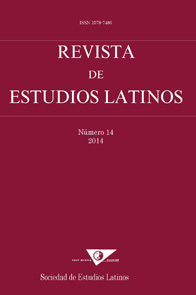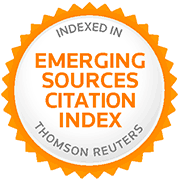Plautus, the Roman Comedy and the Greek Models
DOI:
https://doi.org/10.23808/rel.v14i0.87703Keywords:
Plautus; Terence; palliate; Greek models; stagingAbstract
We know very little about greek models that have inspired Plautus, Terentius and other poets of the palliata. This is why the attempt of reconstruction of their original shapes and even of their details, on the basis of an analytical approach on latin ‘texts of arrival’, is an useless exercise and a merely hypothetical proceeding. Instead the utilization of reliable data preserved by the tradition is helpful to understand how Plautus especially has built his comic dramas by using the greek theater. We will see therefore that he makes use of general and recurrent ‘dramaturgical motifs’ that can be traced back to the New Comedy. By the combination and the creative variation of these ‘motifs’ Plautus composes original comedies in total keeping with his inimitable idea of comic theater.
Downloads
References
AUHAGEN, U. (ed.) (2001): Studien zu Plautus’ Epidicus, Tübingen, Narr.
BAIER, T. (ed.) (1999): Studien zu Plautus’ Amphitruo, Tübingen, Narr.
BAIER, T. (ed.) (2004): Studien zu Plautus’ Poenulus, Tübingen, Narr.
BANDINI, G. (in fieri): Edizione critica, traduzione e commento di Menaechmi 1-272, Dissertazione dottorale, Urbino.
BENZ, L. - LEFÈVRE, E. (1998): (edd.), Maccus barbarus, Tübingen, Narr.
CALABRETTA, M. (2011), Dal testo letterario al testo drammatico: le didascalie della Rudens di Plauto, Dissertazione dottorale, Istituto Italiano di Scienze Umane.
DAMEN, M. L. (1995): «"By the gods,boy ... stop bothering me!: Can’t you tell Menander from Plautus?": or How Dis Exapaton does not help us to understand Bacchides», Antichton 29, 15-29.
DANESE, R. M. (1985): «Plauto, Pseud. 702-705a: la ‘costruzione stilistica’ di un eroe perfetto», MD 14, 101-112.
DANESE, R. M. (1997): «Alta cucina e cibo ‘mortuale’. La polemica culinaria nello Pseudolus: un problema socio-poetico», RAL 9, 8, 499-533.
DANESE, R. M. (2002): «Modelli letterari e modelli culturali del teatro plautino. Qualche problema di metodo», in C. Questa & R. Raffaelli (edd.), Due seminari plautini, Urbino, Quattroventi, 133-153.
DANESE, R. M. (ed.) (2004): Titus Maccius Plautus, Asinaria, Sarsinae et Urbini, Quattroventi.
FRAENKEL, E. (1960): Elementi plautini in Plauto, Firenze, La Nuova Italia.
GAUDREAULT, A. (1999): Du littéraire au filmique. Système du récit, Paris/Québec, Armand Colin.
GOLDBERG, S. M. (1978): «Plautus’ Epidicus and the Case of the Missing Original», TAPhA 108, 81-91.
HANDLEY, E. W. (1968): Menander and Plautus. A Study in comparison, London, University College.
HANDLEY, E. W. (ed.) (1997): «Menander, Dis Exapaton, POxy LXIV 4407», in The Oxyrynchus Papyri, 64, London, British Academy, 14-42.
HANDLEY, E. W. (2001): «Actoris opera: Words, Action, and Acting in Dis Exapaton and Bacchides», in R. Raffaelli & A. Tontini (edd.), Lecturae Plautinae Sarsinates IV. Bacchides, Urbino, Quattroventi, 14-36.
HILDEBRANDT, F. (1884): De Hecyrae terentianae origine, diss. inaug. philol., Halis Saxonum, Ienae, Typis Officinae Frommannianae.
HUTCHEON, L. (2006): A Theory of Adaptation, New York, Routledge.
LAPLACE, M. M. J. (1997): «P. Köln V 203: un modèle de l’acte I du Curculio de Plaute: amour aveugle, amour stupéfié: un esclave et son maître devant les deux aspects de la personnalité d’une jeune fille», in Bärber Kramer et al. (edd.), Akten des 21. Internationalen Papyrologenkongresses: Berlin 13-19 8 1995, Stuttgart-Leipzig, Teubner, 570-577.
LEFEVRE, E. - STÄRK, E. - VOGT- SPIRA, G. (1991): Plautus barbarus. Sechs Kapitel zur Originalität des Plautus, Tübingen, Narr.
LEFÈVRE, E. (1995): Plautus und Philaemon, Tübingen, Narr.
LEFÈVRE, E. (2003/2004): «Asides in New Comedy and the Palliata», LICS 3.3, 1-16.
LOWE, J. B. C. (2001): «Notes on Plautus’ Mercator», WS 114, 143-156.
MAROUZEAU, J. (ed.) (1949): Térence, III, Hécyre - Adelphes, Paris, Les Belles Lettres.
QUESTA, C. (ed.) (1975): T. Maccius Plautus, Bacchides, Firenze, Sansoni.
QUESTA, C. (ed.) (2008): Titus Maccius Plautus, Bacchides, Sarsinae et Urbini, Quattroventi.
QUESTA, C. - RAFFAELLI, R. (1990): «Dalla rappresentazione alla lettura», in Lo spazio letterario di Roma antica, III, La ricezione del testo, Roma, Salerno Editore, 139-216.
RAFFAELLI , R. (2009): Esercizi plautini, Urbino, Quattroventi.
RITSCHL, F. (1845): Parerga zu Plautus und Terenz, 1, Leipzig, Weidmannsche Buchhandlung.
SANTONI, S. (2008): Parlare con le dita. Forme e valori di alcuni gesti significativi del teatro di Terenzio all'epoca moderna, Dissertazione dottorale, Università degli Studi di Siena.
STÄRK, E. (1989): Die Menaechmi des Plautus und kein griechisches Original, Tübingen, Narr.
ZWIERLEIN, O. (1990): Zur Kritik un Exegese des Plautus I. Poenulus und Curculio, Mainz, Franz Steiner.
ZWIERLEIN, O. (1991): Zur Kritik un Exegese des Plautus II. Miles gloriosus, Mainz, Franz Steiner.
ZWIERLEIN, O. (1991a): Zur Kritik un Exegese des Plautus III. Pseudolus, Mainz. Franz Steiner.
ZWIERLEIN, O. (1992): Zur Kritik un Exegese des Plautus IV. Bacchides, Mainz, Franz Steiner.
Downloads
Published
How to Cite
Issue
Section
License
Copyright (c) 2014 Revista de Estudios Latinos

This work is licensed under a Creative Commons Attribution-NonCommercial-NoDerivatives 4.0 International License.
The originals published in the printed and electronic editions of this journal are the property of the Revista de Estudios Latinos and can be circulated as long as the original source and authorship is made clear in any reproduction, full or partial, of the same, and as long as this is not done for commercial purposes.








